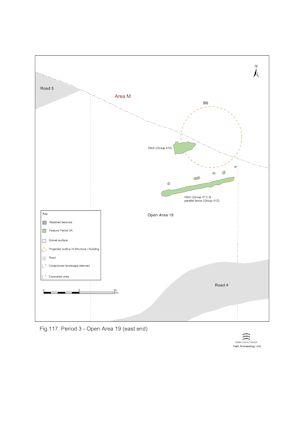
Unlike the west end of OA19, there is insufficient stratigraphic complexity to differentiate the earlier and later Period 3 use of the eastern part. The general lack of remains of this date, where investigated in Excavation Areas L and M, suggests a low and uniform phase of use across it. However, that part of it in the eastern end of Excavation Area H is admittedly covered by later surfacing, little of which was removed. Recorded Period 3 remains are, therefore, almost entirely restricted to its eastern extent (Figure 117).

This pattern of concentrated remains in the west part of the open area and largely vacant remainder is paralleled by OA 23/45. Use of the eastern part of OA19 as an open space is therefore posited.
Ditch 25157 (seg. 15045) was only excavated for a short length and much of the ditch not traced below the upper cobbled surface that covers the northern end of Excavation Area M. It is an irregular-sided linear cut, 1.8m wide and 0.5m deep, running on an ENE-WSW alignment. Although not proven by excavation, a western terminal is hinted at on the pre-excavation plan. It can be dated by its vaguely early Roman pottery and the fact it is under the upper cobbles, thus locating it firmly in this period. Ditch 25157 is presumed to post-date Building 6, demonstrating that this structure is removed during the later 1st century.
Roughly parallel with, and 4.5m south of, 25157 is feature 25158 (seg. 15183), a 10.5m length of ditch that extends off beyond the edge of excavation. It averages around 0.75m wide and 0.25m deep. It is only tentatively assigned to this phase, though its small pottery assemblage is early, as is the coin it contains (SF6647). It terminates at roughly the same point westwards as ditch 25157 and might therefore be associated. However, it might instead be earlier and, with fenceline Group 412 (below), be associated with Building 6 in its latter life.
A line of post-holes (15561, 15600, 15546, 15536, 15534, 15190), running just north of ditch 25158, and parallel to it, may be an accompanying fenceline, which may be presumed contemporary, but there is no real reason other than this to date them as early Roman and they are not wholly convincing as a related group.
Single pit 16469 constitutes the only Period 3 feature identified outside of the west end of OA19, though still within Excavation Area H. The fill of this small and shallow cut contains only a small quantity of animal bone and a tile tessera (which may suggest that it is more likely of 2nd century date). Of similar proportion to those scattered further west, it is uncertain whether this pit simply denotes their eastward spread or not. As noted previously, overlying later surfaces were not removed over large parts of this vicinity so the incidence of further such pitting cannot be established.
Internet Archaeology is an open access journal based in the Department of Archaeology, University of York. Except where otherwise noted, content from this work may be used under the terms of the Creative Commons Attribution 3.0 (CC BY) Unported licence, which permits unrestricted use, distribution, and reproduction in any medium, provided that attribution to the author(s), the title of the work, the Internet Archaeology journal and the relevant URL/DOI are given.
Terms and Conditions | Legal Statements | Privacy Policy | Cookies Policy | Citing Internet Archaeology
Internet Archaeology content is preserved for the long term with the Archaeology Data Service. Help sustain and support open access publication by donating to our Open Access Archaeology Fund.